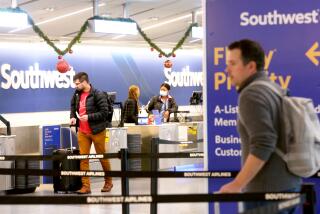AIRLINES : When Travelers Get Their Wings Clipped
- Share via
Brazilian tourist Fernanda Coelho came to Los Angeles to check out the sights. But since the death of Pan American World Airways last week, she’s been checking want ads instead, hunting for work so she can earn money for a ticket home.
Coelho is among the thousands of travelers who got stuck with worthless tickets when Pan Am, the largest U.S. carrier to South America, shut down Dec. 4. Though several U.S. airlines announced that they are accepting Pan Am tickets for standby travel, none fly to South America.
For the record:
12:00 a.m. Dec. 14, 1991 For the Record
Los Angeles Times Saturday December 14, 1991 Home Edition Business Part D Page 2 Column 6 Financial Desk 1 inches; 34 words Type of Material: Correction
Airlines--The airline industry is opposed to a congressional proposal to require the industry to develop a plan to transport stranded passengers after an airline fails. An article in Friday’s editions misstated the industry’s position.
In fact, only one airline that goes to South America is taking Pan Am tickets. Varig Brazilian Airlines is charging stranded Pan Am customers a standby fare of $687 for one-way travel between Los Angeles and Rio de Janeiro. While that price is a bargain compared to the usual $1,200 one-way fare, it is too steep for some.
With thousands of stranded travelers facing huge ticket costs, Pan Am’s demise has rekindled the controversy over how the airline industry responds when a carrier fails. Legislation pending in Congress would require other airlines to honor tickets issued by defunct carriers, a measure consumer activists say is badly needed as the industry’s finances deteriorate.
But the airlines contend that it is unfair to force them to pick up the cost of transporting passengers stuck with worthless tickets. “It’s a little like telling Ford and General Motors to honor Chrysler warranties,” said a spokesman for the Air Transport Assn., the industry’s lobbying group.
The collapse of an international carrier such as Pan Am hits consumers especially hard because there are no practical, inexpensive alternatives to air travel.
At least one strapped tourist tried to get the government to pick up the tab.
With her pockets nearly empty, Brazilian Marcia Robeiro asked the U.S. Immigration and Naturalization Service to deport her. The INS turned her down; her tourist visa is valid until April.
Other airlines voluntarily accepted a failed carrier’s tickets until 1983, when Continental Airlines declared bankruptcy.
Continental dropped unprofitable routes while continuing to fly profitable ones. The move angered Continental’s competitors, which refused to bear the cost of transporting passengers that Continental abandoned.
Legislation sponsored by Rep. Sherwood Boehlert (R-N.Y.) would require the industry to develop a plan to transport stranded passengers after an airline fails. The legislation would require the transportation secretary to come up with a plan if the industry fails to do so.
The industry contends that the legislation, now before the House Public Works and Transportation Committee, is necessary because most airlines pitch in to fly abandoned passengers to their destinations.
But consumer activists say the industry’s response to Pan Am’s collapse is inadequate, particularly since American Airlines--the only U.S. carrier to serve South America--isn’t taking Pan Am tickets. American contends that it can’t afford to transport non-paying passengers at a time when it is losing money.
United Airlines, which expects to start flying some of Pan Am’s South American routes in mid-January, hasn’t decided whether to accept Pan Am tickets.
“The consumer is at the mercy of the generosity of each individual airline,” said Richard Livingston of the International Airline Passengers Assn., a consumer group. “
It isn’t known how many international travelers were stranded when Pan Am shut down. Pan Am spokesman Al Topping said the airline transported 13,000 people the day it ceased operations, but has no record of how many of those were headed home. It also has no record of how many people were set to travel home in subsequent days or weeks, he said.
Travel agents who specialize in South America say they’ve been shelled with faxes and phone calls from Pan Am customers marooned in cities throughout South America.
The more than $1,000 one-way fare between Los Angeles and Brazil is “pretty steep” for many travelers, said Stephen Foster of Brazil Tours and Travel in Sun Valley. “I have a client in Santiago (Chile)--he’s traveling with his wife. I’m not sure he’s going to make it back.”
For foreign tourists without access to funds, the decision to stay here and work for air fare raises tricky legal questions.
A spokeswomen for the INS said the law doesn’t permit it to hand out so-called green cards to stranded tourists who need them to work legally.
“I feel like a Grinch, but there’s really no provision in the law for it,” INS spokeswoman Virginia Kice said.
Coelho, 29, said family members in Brazil are pooling funds to help purchase return tickets for her and her sister Paula, 20. In the meantime, the sisters are staying with friends and applying for baby-sitting positions.
Paula has already received one job offer. “We’re not legal, so it’s really the only job we can do,” Fernanda, an actress, said of the baby-sitting.
More to Read
Sign up for The Wild
We’ll help you find the best places to hike, bike and run, as well as the perfect silent spots for meditation and yoga.
You may occasionally receive promotional content from the Los Angeles Times.






